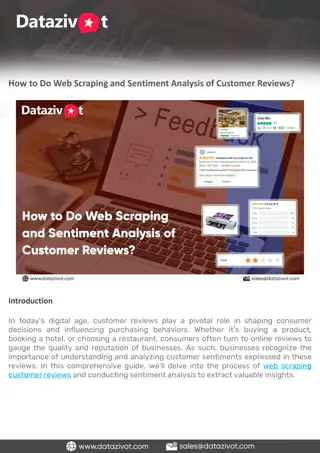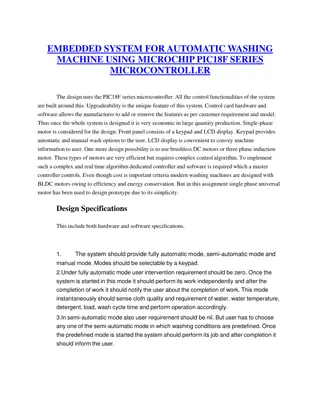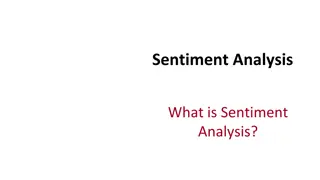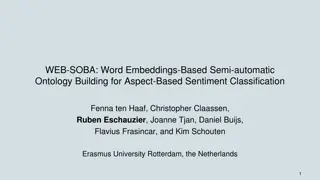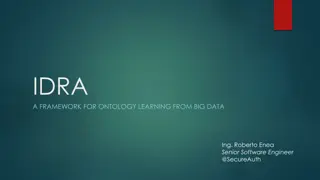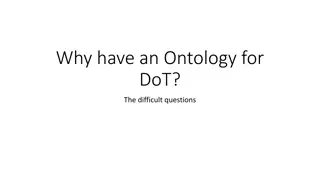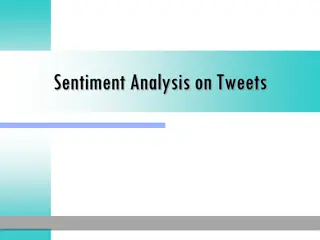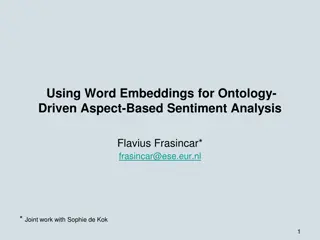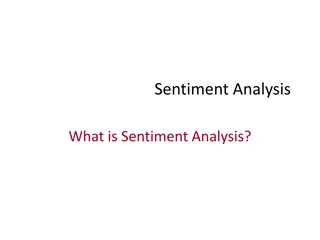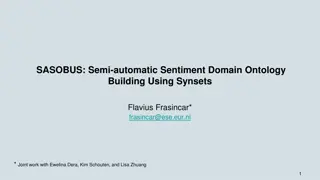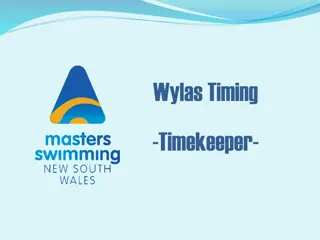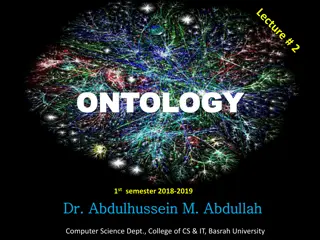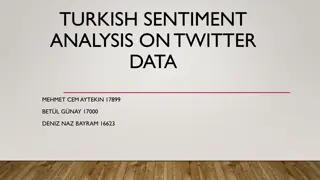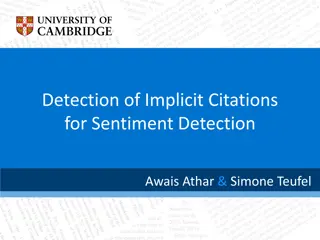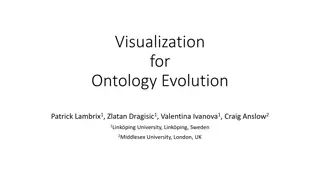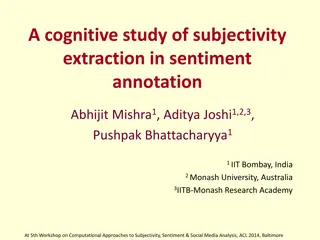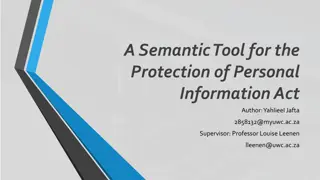Semi-Automatic Ontology Building for Aspect-Based Sentiment Classification
Growing importance of online reviews highlights the need for automation in sentiment mining. Aspect-Based Sentiment Analysis (ABSA) focuses on detecting sentiments expressed in product reviews, with a specific emphasis on sentence-level analysis. The proposed approach, Deep Contextual Word Embeddings-Based Ontology Building, aims to enhance ABSA with a semi-automatic process, leveraging both ontology-based reasoning and deep learning techniques. By extending ontology representation with adverbs and utilizing contextual word embeddings, the research seeks to address the challenge of building domain sentiment ontology for ABSA at the sentence level.
Download Presentation

Please find below an Image/Link to download the presentation.
The content on the website is provided AS IS for your information and personal use only. It may not be sold, licensed, or shared on other websites without obtaining consent from the author. Download presentation by click this link. If you encounter any issues during the download, it is possible that the publisher has removed the file from their server.
E N D
Presentation Transcript
DCWEB-SOBA: Deep Contextual Word Embeddings-Based Semi-Automatic Ontology Building for Aspect-Based Sentiment Classification Flavius Frasincar* frasincar@ese.eur.nl * Joint work with Roos van Lookeren Campagne, David van Ommen, Mark Rademaker, and Tom Teurlings 1
Contents Motivation Related Work Data Methodology Evaluation Conclusion 2
Motivation Growing number of reviews: In 2020: the number of reviews on Amazon around 250 million Growing importance of reviews: 80% of the consumers read online reviews 75% of the consumers consider reviews important Reading all reviews is time consuming, therefore the need for automation 3
Motivation Sentiment miningis defined as the automatic assessment of the sentiment expressed in text (in our case by consumers in product reviews) Several granularities of sentiment mining: Review-level Sentence-level Aspect-level (product aspects are sometimes referred to as product features): Aspect- Based Sentiment Analysis (ABSA): Review-level Sentence-level [our focus here] 4
Motivation Aspect-Based Sentiment Analysis (ABSA) has two stages: Aspect detection: Explicit aspect detection: aspects appear literally in product reviews Implicit aspect detection: aspects do not appear literally in the product reviews Sentiment detection: assigning the sentiment associated to explicit or implicit aspects [our focus here] Three approaches for ABSA: Knowledge Representation (KR) Machine Learning (ML) Hybrid: current state-of-the-art, e.g., A Hybrid Approach for Aspect-Based Sentiment Analysis++ (HAABSA++) proposed by Trusca, Wassenberg, Frasincar, and Dekker (2020) 5
Motivation HAABSA++ is a two-step approach for ABSA at sentence-level: 1. Ontology-based reasoning 2. Deep learning (backup solution) The domain sentiment ontology is manually constructed: Available only for some domains (restaurants and laptops) Limited coverage Research question: How to build in a semi-automatic manner a domain sentiment ontology for ABSA at sentence-level? In addition we aim to extend the ontology representation by means of adverbs (e.g., carefully in carefully prepared denotes positive sentiment) and make use of contextual word embeddings during ontology building 6
Related Work ABSA There are several hybrid approaches for ABSA: Ont+BoW by Schouten and Frasincar (2018): a two-step approach with ontology-based reasoning and an SVM classifier as backup Ont+LCR-Rot-hop (HAABSA) by Wallaart and Frasincar (2019): a two-step approach with ontology-based reasoning and a neural network with rotatory attention performed in multiple hops using GloVe embeddings (context-independent) as backup Ont+LCR-Rot-hop++ (HAABSA++) by Trusca, Wassenberg, Frasincar, and Dekker (2020): a two-step approach with ontology-based reasoning and a neural network with rotatory and hierarchical attention performed in multiple hops using BERT embeddings (context-dependent) as backup 7
Related Work Ontology Building The ontology building is based on (sentiment annotated) domain corpora There are several approaches to build ontologies for ABSA: SOBA by Zhuang, Schouten, and Frasincar (2020): uses word co-occurences SASOBUS by Dera, Frasincar, Schouten, and Zhuang (2020): uses word and synset co- occurences (synsets deal with polysemous words) WEB-SOBA by ten Haaf, Claassen, Enschauzier, Tjan, Buijs, Frasincar, and Schouten (2021): uses word2vec representations (context-independent) WEB-SOBA outperforms SASOBUS on accuracy and time-efficiency (SASOBUS not used in the evaluation) 8
Data Domain corpus: Yelp Open Dataset for restaurants 2,000 restaurant reviews 200,000 unique words Each review has text and star rating (1 to 5) BERT base (uncased) which is trained on: BookCorpus (800M words) Wikipedia (2500M words) Remove review sentences containing negation words (e.g., not , never , etc.), so 10.4% of review sentences are removed (so that word embeddings reflect true word polarity) 9
Data Training and testing data: SemEval 2016, Task 5, Subtask 1, Slot 3 for restaurants 3,365 opinions (target, aspect, and sentiment polarity, i.e., negative, neutral, and positive) Training data: 350 reviews 2000 sentences 1879 opinions (after removal of opinions with implicit aspects) Test data: 90 reviews 676 sentences 650 opinions (after removal of opinions with implicit aspects) 10
Data Example: Aspect categories: FOOD, AMBIENCE, DRINKS, LOCATION, RESTAURANT, EXPERIENCE, and SERVICE Aspect attributes: PRICES, QUALITY, STYLE&OPTIONS, GENERAL, and MISCELLANEOUS 11
Data The most dominant sentiment is positive Almost all sentences have between 0 and 3 opinions 12
Methodology Deep Contextual Word Embedding-Based Semi-Automatic Ontology Builder for Aspect-Based Sentiment Analysis (DCWEB-SOBA) Word Embeddings Construction Skeletal Ontology Building Term Selection Sentiment Term Clustering Aspect Term Clustering 13
Ontology Structure The ontology structure is defined by Schouten and Frasincar (2018) and is based on three types of sentiment words: Type 1: Words that have always the same sentiment and are independent of an aspect (e.g., good ) Type 2: Words that belong to one or more aspects but not to all aspects and are always positive, negative, or neutral (e.g., delicious belongs to DRINKS#QUALITY and FOOD#QUALITY and is always positive) Type 3: Remaining sentiment words, which are words that are positive, negative, or neutral depending on the context (e.g., Fries Cold Negative and Beer Cold Positive) The domain sentiment ontology models only positive or negative sentiment (neutral sentiment has an inherent ambiguity) in addition to domain aspects The domain sentiment ontology is represented in OWL 14
Word Embeddings Construction BERT base (uncased): takes in account polysemous words Three variants: Pre-trained: BookCorpus and Wikipedia Uses general word semantics Post-trained: 50,000 reviews from the Yelp dataset Takes domain word semantics into account Fine-tuned: 100,000 reviews from the Yelp dataset Takes domain word polarity into account Use 2D t-SNE diagrams to qualitatively evaluate the quality of the word embeddings BERT post-trained did not separate well the word meanings possibly due to the limited domain corpus 15
Polysemy-Aware Word Embeddings Pre-trained BERT Good separation of Turkey#A (animal) and Turkey#B (country) Pizza is near Turkey#A and Italy is near Turkey#B (as expected) 16
Sentiment-Aware Word Embeddings Pre-trained BERT Poor separation of hate and love 17
Sentiment-Aware Word Embeddings Fine-tuned BERT Good separation of words with different polarity 18
Skeletal Ontology Building The ontology has two main classes: SentimentValue has two subclasses: Positive and Negative Mention has four subclasses: ActionMention: represents verbs EntityMention: represents nouns PropertyMention: represents adjectives ModifierMention: represents adverbs Each Mention class has two subclasses (where <Type> denotes Action, Entity, Property, or Modifier): GenericPositive<Type>:also a subclass of Positive GenericNegative<Type>: also a subclass of Negative 19
Skeletal Ontology Building Each aspect has the form CATEGORY#ATTRIBUTE and for each <Type>Mention we generate two subclasses: <Category><Type>Mention <Attribute><Type>Mention We consider all seven aspect categories: FOOD, AMBIENCE, DRINKS, LOCATION, RESTAURANT, EXPERIENCE, and SERVICE We consider only three attributes: PRICES, QUALITY, STYLE&OPTIONS (split in STYLE and OPTIONS), as GENERAL, MISCELLANEOUS are too general For each <Category/Attribute><Type>Mention we add two subclasses: <Category/Attribute>Positive<Type> <Category/Attribute>Negative<Type> 20
Skeletal Ontology Building To each <Category/Attribute><Type>Mention we attach two properties: lex: denotes an associated lexical representation aspect: denotes a corresponding aspect of the format CATEGORY#ATTRIBUTE GenericPositive<Type> and GenericNegative<Type> have initially defined subclasses that denote concepts associated to general concepts that have lexical representations such as hate , love , good , bad , disappointment , and satisfaction 21
Term Selection Stanford POS tagger used to extract nouns, verbs, adjectives, and adverbs 11 Mention base classes for aspects: A = {Restaurant, Location, Food, Drinks, Price, Experience, Service, Ambiance, Quality, Style, and Options} For each base aspect class we compute the average of the word embeddings associated to the class lexical representations (assume non-ambiguous meaning for these lexical representations) We use Mention Class Similarity (MCS) to find terms that are specific for our domain: ?? ?? ?? ??? ? = max ?? ? ? where ? is a term found in our domain corpus and ? is one of the basic aspects (? denotes the associated vectors) 23
Term Selection Words that have an MCS value below a certain threshold (0.68, given by the tradeoff between accuracy and coverage on our data) are removed After obtaining the relevant terms, we compute the average word embedding (as a word can have different embeddings) the high MCS values ensure that the selected terms have only one meaning associated to determine new MCS values that give the order of the suggested terms In order to suggest the right amount of words, per POS, a minimum threshold for MCS needs to be determined: ???????? ? + 1 ????? = max ????? where ???????? denotes the number of accepted terms and ? is the number of suggested terms (+1 avoids threshold of 100%) 24
Term Selection If a term is a noun or a verb: The user decides if it is an Aspect Mention or a Sentiment Mention If a term is an adjective or an adverb: The term is automatically designated as a SentimentMention If a term is a SentimentMention: The user decides if it is: Type 1 SentimentMention Type 2 SentimentMention Type 3 SentimentMention For each accepted word we add all similar words that have a cosine similarity higher than a certain threshold (0.7) to the ontology, as well 25
Sentiment Term Clustering Set of base positive words: P = { good , decent , great , tasty , fantastic , solid , yummy , terrific } Set of base negative words: N = { bad , awful , horrible , terrible , poor , lousy , shitty , horrid } For each base sentiment word we compute the average sentiment-aware word embedding (as a word can have different sentiment-aware word embeddings) We calculate the Positive Score (PS) and Negative Score (NS): ?? ?? ?? ?? where ? is a sentiment term, ? is a positive word, and ? is a negative word (? denotes the associated vectors) ?? ?? ?? ?? ? = max ?? ? = max ?? ? ? ? ? 26
Sentiment Term Clustering The largest value between PS and NS indicates the corresponding sentiment The user: For Type-1 sentiment words, decides if the sentiment is correct and, and, if wrong, makes correction For Type-2 and Type-3 sentiment words, which are aspect-specific, checks the closest <Category/Attribute><Type>Mention using the cosine similarity: If accepted, the user checks the polarity, and, if wrong, makes correction and continues to the next more similar <Category/Attribute><Type>Mention If rejected, the current sentiment word is fully processed Interestingly, Type-2 and Type-3 sentiment words are treated in the same way, as only the parent sentiment class changes for Type-3 sentiment words based on user sentiment corrections 27
Aspect Term Clustering Using MCS the term is allocated to the closest base aspect We apply hierarchical clustering using Average Linkage Clustering (ALC) distance: 1 ? ? ??? ?,? = ?(?,?) ? ? ? ? where ?(?,?) is the Euclidian distance between vector ? (from cluster ?) and ? (from cluster B) Using the elbow method the depth of the hierarchy is 3 subclasses The user: Decides if the term is placed in the correct base aspect, and if wrong, makes correction (all terms start in the right base cluster before performing hierarchical clustering) 28
Evaluation DCWEB-SOBA has the largest amount of classes and second largest number of lexicalizations (due to adverbs and word polysemy) DCWEB-SOBA requires more user time than WEB-SOBA DCWEB-SOBA requires less computing time than WEB-SOBA as fine-tunning BERT embeddings (120 minutes) is faster than building word2vec embeddings (300 minutes) 29
Evaluation DCWEB-SOBA is conclusive in more cases than WEB-SOBA, but less than the other methods DCWEB-SOBA has a better accuracy than WEB-SOBA for ontology reasoning (on the conclusive cases) DCWEB-SOBA has the best accuracy for the combing approach (HAABSA++) 30
Conclusion We have proposed DCWEB-SOBA, a semi-automatic method for domain sentiment ontology construction using deep contextual word embeddings (BERT) for ABSA at sentence-level: Word Embeddings Construction Skeletal Ontology Building Term Selection Sentiment Term Clustering Aspect Term Clustering We have used two restaurant datasets: Yelp Open Dataset for ontology building SemEval 2016, Task 5, Subtask 1, Slot 3 data for measuring performance We have employed BERT base (uncased), pre-trained on BookCorpus and Wikipedia 31
Conclusion We have shown that DCWEB-SOBA (based on deep contextual word embeddings) ontology is more conclusive, more accurate, and requires less time to build than WEB-SOBA (based on context-independent word embeddings) DCWEB-SOBA ontology gives the best accuracy in a hybrid approach (HAABSA++) Future work: Apply DCWEB-SOBA to other domains (e.g., laptops) in addition to restaurants Fine-tune the BERT model on aspect sentiment instead of review sentiment Experiment with other deep contextual word embeddings like RoBERTa (trained on a 10 times larger dataset than BERT) 32
References ABSA Kim Schouten and Flavius Frasincar. Ontology-Driven Sentiment Analysis of Product and Service Aspects. 15th Extended Semantic Web Conference (ESWC 2018), LNCS, Volume 10843, pages 608-623, Springer, 2018. Olaf Wallaart and Flavius Frasincar. A Hybrid Approach for Aspect-Based Sentiment Analysis Using a Lexicalized Domain Ontology and Attentional Neural Models. 16th Extended Semantic Web Conference, LNCS, Volume 11503, pages 363-378, Springer, 2019. Maria Mihaela Trusca, Daan Wassenberg, Flavius Frasincar, and Rommert Dekker. A Hybrid Approach for Aspect-Based Sentiment Analysis Using Deep Contextual Word Embeddings and Hierarchical Attention. 20th International Conference on Web Engineering, LNCS, Volume 12128, pages 365-380, Springer, 2020. 33
References Ontology Building Lisa Zhuang, Kim Schouten, and Flavius Frasincar. SOBA: Semi- Automated Ontology Builder for Aspect-Based Sentiment Analysis, Journal of Web Semantics, Volume 60, Article 100544, 2020. Ewelina Dera and Flavius Frasincar. SASOBUS: Semi-automatic Sentiment Domain Ontology Building Using Synsets. 17th Extended Semantic Web Conference, LNCS, Volume 12123, pages 105-120, Springer, 2020. Fenna ten Haaf, Christopher Claassen, Ruben Eschauzier, Joanne Tjan, Dani l Buijs, Flavius Frasincar, and Kim Schouten. WEB-SOBA: Word Embeddings-Based Semi-automatic Ontology Building for Aspect-Based Sentiment Classification, 18th Extended Semantic Web Conference, LNCS, Volume 12731, pages 340-355, Springer, 2021. 34



